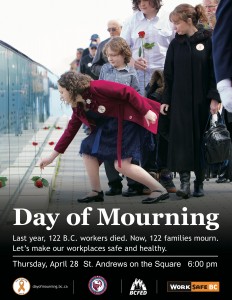
2016 Day of Mourning Calls for Asbestos Ban
This April 28th, Canadian unions are calling for a comprehensive national ban on asbestos , a known killer that causes disease, suffering and death—all of it preventable. We want the federal government to pass legislation that outlaws the use, exportation, and import of asbestos.
More than 2,000 people die every year in Canada from diseases caused by exposure to asbestos, such as mesothelioma,1 lung cancer and asbestosis.2 Asbestos exposure is the number one cause of occupational death in Canada, and since 1996, asbestos-related diseases have accounted for about a third of the workplace deaths recognized by workers’ compensation boards.
Deaths from mesothelioma increased by 60 percent between 2000 and 2012. Despite these disturbing facts, imports of items that contain asbestos, like brake pads and cement pipes, are on the rise (in 2014, imports of asbestos brake linings and pads hit a seven-year high, valued at $3.6 million that year alone). These products, as well as the lack of a formal registry of buildings known to contain asbestos, increase workers’ risk of exposure to a known killer.
Safer alternatives
This risk of asbestos exposure is preventable and completely unacceptable given that there are safe alternatives. Asbestos-free brake pads are manufactured in Guelph, Ontario, and asbestos-free ceiling tiles are produced in Langley, BC. Substituting these safer alternatives for deadly asbestos also creates Canadian jobs and support Canadian industries. Plans for new spending on infrastructure at all levels of government make it even more urgent that an asbestos ban be put in place now to guarantee that projects such as construction and upgrades to roads, transit stations, and other public places remain asbestos free.
National Day of Mourning Background
The National Day of Mourning, held annually on April 28, was officially recognized by the federal government in 1991, eight years after the day of remembrance was launched by the Canadian Labour Congress. The Day of Mourning has since spread to about 80 countries around the world and has been adopted by the AFL- CIO and the International Confederation of Free Trade. Every year since, local unions and labour councils have marked the day with ceremonies of remembrance for colleagues, friends and family who have been killed, injured, or suffered serious health consequences because of workplace-related hazards and incidents.
Each year, approximately 1,000 Canadian workers are killed on the job (more than 2.5 workers per day). In the 20 year period from 1995 to 2014, 18,039 people lost their lives due to work-related causes (an average of 918 deaths per year). Hundreds of thousands more are injured, and countless thousands become permanently disabled or die from work-related diseases.
Honouring these individuals not only demonstrates our respect and support for affected workers and their families, but is also a vital means of creating public awareness of workplace hazards and toxins. It helps us to reinforce our ongoing commitment to fighting for safer workplaces and demanding that negligent employers are held accountable.
Unions have already made a difference over the past year by reducing the hazards people face when working in confined spaces and helping to make the workplaces of Canadians (not just union members) much safer and healthier. Through labour councils, the BC Federation of Labour, and the Canadian Labour Congress, unions have also fostered workplace protections for victims of domestic violence, with changes to provincial laws moving forward in Alberta, Manitoba, and Ontario. Recognizing that not all injuries are physical, unions are also taking on the stigma of mental illness and factoring it into what makes a workplace healthy and safe.
This year, Canada can take a giant step forward with a comprehensive ban on asbestos that will help to make all of our workplaces, homes and public spaces safer and healthier.
Kamloops Day of Mourning Ceremony
The Kamloops and District Labour Council will host a Day of Mourning ceremony On April 28, 2016 (6:00 pm) at St. Andrew’s on the Square and invites everyone to attend. The event will include guest speakers, a sidewalk march to lay the wreath, lighting of memorial candles, and music provided by Gail Ovington (piano), Jake Dogteron (trumpet), and Lorne Bailey (bagpipes).
Workers are also encouraged to observe a moment of silence and fly flags at half- mast at their worksites on April 28th.
An injury to one is an injury to all.
For more information about the Kamloops event, please contact Jim Waldie at waldiejames@gmail.com.
To learn more about the National Day of Mourning, visit dayofmourning.bc.ca. If you would like to leave a note in honour a fallen family member or worker, please visit the Day of Mourning commemoration site at dayofmourning.bc.ca. You can also request complimentary Day of Mourning decals and posters through this website.
- Mesothelioma: mez-oh-thee-lee-oh-ma A rare form of cancer that develops from cells of the protective lining that covers the internal organs of the body. Signs and symptoms include shortness of breath due to fluid between the lung and the chest wall, chest wall pain and constitutional signs such as unexplained weight loss. Mesothelioma is most commonly caused by exposure to asbestos (Sources: wikipedia.com and merriam- webster.com).
- Asbestosis: az-bess-toe-sis A chronic inflammatory and scarring disease affecting the tissue of the lungs. People with the condition may experience severe shortness of breath and are at an increased risk for certain cancers, including lung cancer. Asbestosis specifically refers to fibrosis within the lung tissue from asbestos, and not scarring around the outside of the lungs. It is caused by the breathing in and retention of asbestos fibres (Sources: wikipedia.com and merriam-webster.com).








